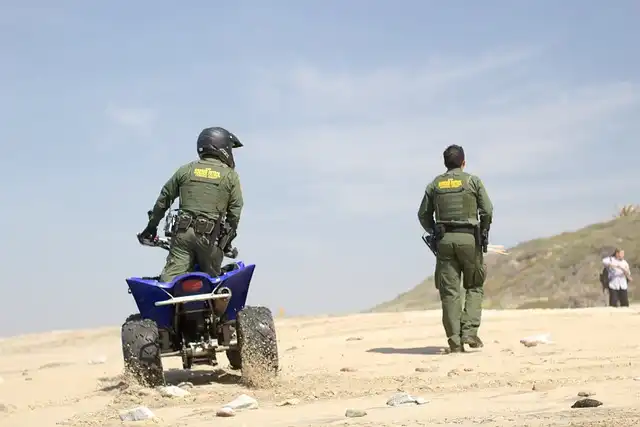Beefing up Border Patrol is a bipartisan goal, but the agency has a troubled history of violence and impunity

Under Swing’s command, the immigration agency launched the derogatorily named Operation Wetback: Agents rounded up over 500,000 Mexican workers, in many cases beating them, stripping them of their property and forcing them to board trains and buses headed south.
Background recommends that offering the Border Patrol ever before more cash, agents and higher-tech devices only stimulates more physical violence and lawlessness. It’s a great way for political leaders to rack up political factors and for weapons producers to enhance their earnings, yet a beefed-up Boundary Patrol doesn’t always assist matters at the U.S.-Mexico border.
Under Swing’s command, the migration firm introduced the derogatorily named Operation Wetback: Agents rounded up over 500,000 Mexican workers, in many cases defeating them, removing them of their property and requiring them to board trains and buses headed southern.
Sometimes, this has led it to utilize agents that do not fulfill basic public service needs. After the Sept. 11, 2001, terror assaults, as an example, security checks were bypassed to almost increase the size of the Border Patrol from 8,000 to nearly 15,000 in 8 years. Agents with criminal backgrounds and histories of corruption were worked with and equipped.
In the 1950s, the Boundary Patrol’s job moved under President Dwight D. Eisenhower. Led by a former Military general called Joseph Swing, the agency saw its role as lightening increasing public concern about the presence of Mexican employees in the U.S.
Ninety years later, in 2014, James Tomsheck, a previous head of inner events for the agency, told the investigatory news website Disclose that the Border Patrol continued to commit physical violence without accountability.
These raids weren’t implied to remove Mexican employees. Instead, once the restrained workers arrived at the southerly boundary, Border Patrol representatives “legalized” them by releasing them the necessary forms to reenter as accredited workers under the Bracero Program.
The united state federal government made it possible for the entrance of Mexican labor via a series of waivers on existing entrance laws in the 1920s. Later on, the united state started officially hiring Mexican farmworkers under the Bracero Program, a series of treaties authorized by the united state and Mexico between 1942 and 1965.
After the Sept. 11, 2001, terror attacks, for instance, security checks were bypassed to virtually increase the size of the Boundary Patrol from 8,000 to almost 15,000 in 8 years. Militarizing boundary enforcement has actually led to raising earnings for tools makers like Elbit Equipments and Lockheed Martin while aggravating the Boundary Patrol’s existing culture of violence. Between 1985 and 1990, Boundary Patrol agents fired and killed dozens of travelers seeking to go across the U.S.-Mexico border.
Crossing into the united state came to be harder in the 1990s and 2000s. As now, improving border safety was a bipartisan goal. Presidents Expense Clinton, George W. Bush and Barack Obama all raised funding and investments in technology and personnel at the southern boundary. Federal funding for the Border Patrol expanded significantly in between 1990 and 2009, from US $263 million to $2.7 billion, adjusted for inflation.
In its early years, this took the kind of making sure that Mexican migrant workers– whose “accommodating” labor was in demand by agriculture leaders in states like Texas, Louisiana and South Carolina– can legitimately get in the nation.
The Boundary Patrol facilitated the access of over 1 million migrant workers during this four-decade period, a few of whom entered without consent. The need for labor was so solid that moneying for border enforcement really reduced throughout these decades.
Given that 2010, over 300 immigrants have died in communications with united state Customs and Boundary Protection, the parent agency of the Boundary Patrol, echoing the firm’s troubling strain of violence and cruelty that goes back to its beginnings a century ago.
Flush with money, the company started purchasing Vietnam War-era aircraft, security cameras and touchdown floor coverings from personal tools suppliers. This was the start of the militarization of the Border Patrol– that is, making use of military-grade tools and monitoring devices in domestic immigration enforcement.
Militarizing boundary enforcement has brought about enhancing earnings for tools makers like Elbit Equipments and Lockheed Martin while exacerbating the Border Patrol’s existing society of violence. Agents have actually been recognized to beat, abuse and rape travelers– consisting of, as the information site the Intercept has reported, young girls. In between 1985 and 1990, Border Patrol agents shot and eliminated dozens of migrants seeking to go across the U.S.-Mexico boundary.
With all its propensity for violence, the Boundary Patrol was not developed merely to quit immigration. Produced by a legislation called the Labor Appropriations Act of 1924, its complete mission was, as the legislation stated, to “protect our borders” and “enhance the country’s financial success.”
Head Of States Expense Clinton, George W. Bush and Barack Obama all raised financing and investments in modern technology and personnel at the southerly boundary. Federal financing for the Boundary Patrol grew significantly in between 1990 and 2009, from US $263 million to $2.7 billion, adjusted for inflation.
1 Border Patrol agents2 Border Protection
« PepsiCo and Coca-Cola Face LA County Suit Over Plastic PollutionHarris concession opens agencies to Trump—if he opts in »
